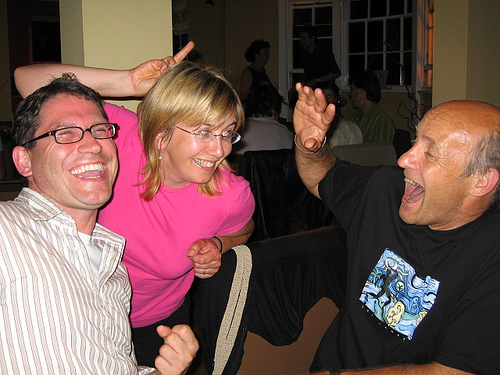Last week while I was on the road, in response to the Tweets and two online events for #change11, I received a wonderful email from one of my online friends, Steve Crandall (aka “imaginary friends” which means we have not yet met F2F) which warmed the cockles of my heart…some real life stories about “social artists” which was. One of the core ideas I hoped to chew on this week with the good folks of #change11. (If you are lost about the meaning of #change 11, look here and here.) Steve wrote:
Hi Nancy
I was looking at your video conference on social artistry. The role of the listener/synthesizer is very important. We had one in an inventor’s circle at Bell Labs – of the four of us was one person who rarely offered the new core ideas, but rather would listen to the three of us hash things out for an hour quietly and then say ‘let me see if I understand this” he was enormously broad and connections none of us had imagined would surface giving new directions. He also had rich connections to other people where he served in a similar role. He was far and away the most important guy in our group. I should note that he was older and his background was *extremely* diverse.
It reminded me of an old notion that Bonnie Nardi and I had on the “library gene” — the folks who navigate content for the rest of us. We measured it for music and found they were about as common as numbers people talk about for literature. There was speculation that perhaps this type of person exists to curate social graphs as well as technical graphs — I’m certain they exist. I know one at Pixar who is spectacular. In theory a group leader should have some of these skills – in practice I think they are rare (at least natively perhaps people can learn)
best
Steve
 I immediately wrote him back before I headed, yet again, to the airport and asked if I could share his email alnd if he might join us for our second session on friday at 9am PDT. Here’s what he wrote:
I immediately wrote him back before I headed, yet again, to the airport and asked if I could share his email alnd if he might join us for our second session on friday at 9am PDT. Here’s what he wrote:
Feel free to post Nancy
I don’t know my schedule on Friday – I may be traveling – but I can offer more detail if you like. I’m very interested in this class of person.
Early on in my Bell Labs career I spent some time working with the silicon production people at the Western Electric Allentown PA Works. A dingy place that was built in WWII, but was the leading edge of AT&T’s electronic production at the time. The silicon process was had a lot of black magic and art in it. People roughy understood it, but there was a considerable amount of tuning and local knowledge – small changes often led to expensive disasters. There was a guy who was technically a process manager, but his unconventional habit of walking around and asking everyone deep questions was allowed as he had the respect of people. He would bring together very disparate people (that’s how I got involved – I was giving a talk at Murray HIll in NJ that he visited and he thought I needed to look at something in Allentown – it wasn’t a problem for them, but he wanted to plant seeds and involve people who might be useful in the future. Unofficially he was known as “the major of Allentown”. He successfully tied about 25 groups of technologists together. I’m still astounded at his curiosity and connections.
The phrase “connect the dots” means a lot to me. We generally think of it in idea space, but it is clearly present in other areas I think SSTEM only education is a mistake as it focuses too much, bu that is a different subject. I don’t know if you saw it, but here is a general post on this type of person (although it doesn’t get into the social graph navigators and librarian gene people)
http://tingilinde.typepad.com/omenti/2011/08/polymaths-connect-the-dots.html
You know, Steve is a “connect the dots” sorta guy. Yes, a social artist! More on social artists in the next few days as I continue to synthesize what I learned last week from the MOOC Change11.
P.S. Edit on Tuesday — you might enjoy Steve’s second and very thoughtful blog, Omenti.
